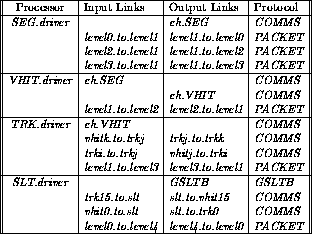The CTD-SLT algorithms execute in a network of transputers
mounted on 16 ROC boards.
Figure 2 shows the trigger network.
It consists of 16 pipelines and a chain![]() .
The first three levels are responsible for a 16'th of the
CTD readout channels only.
Besides this geometrical parallelism, each level of
processing takes place in parallel and hence the system
provides an inherent buffer of approximately five events.
After accounting for the links running the harness protocol,
the remaining links are left for point-to-point
communication and the passing of trigger data between nodes.
Table 1 shows the processor characteristics of each
CTD-SLT transputer.
Level zero processes the input data for the SLT proper
(levels 1-4), while level five reads out data to the event
builder (EVB).
.
The first three levels are responsible for a 16'th of the
CTD readout channels only.
Besides this geometrical parallelism, each level of
processing takes place in parallel and hence the system
provides an inherent buffer of approximately five events.
After accounting for the links running the harness protocol,
the remaining links are left for point-to-point
communication and the passing of trigger data between nodes.
Table 1 shows the processor characteristics of each
CTD-SLT transputer.
Level zero processes the input data for the SLT proper
(levels 1-4), while level five reads out data to the event
builder (EVB).
Figure 2: CTD-SLT Trigger Network.

Table 1: CTD SLT and Readout Processors.
Each transputer runs a number of processes; these are listed in Table 2. Table 3 describes the function of each link and the protocol run on it. The harness protocol, PACKET, is used for the passing of monitor data, control information, and input data to the trigger. The COMMS protocol is for passing trigger data between the SLT processing nodes. References to leveln.to.levelm refer to a harness link between levels n and m of the SLT network, while link trki.to.trkj transfers the track data from node i to node j in the chain. Similarly, link vhitj.to.trki transfers vector hit data from node j to node i in the chain. GSLTB is the link from the CTD-SLT to the global second level trigger box (GSLTB).

Table 3: CTD-SLT Interconnections.